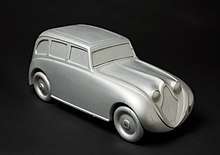Volvo Venus Bilo
The Volvo Venus Bilo was a concept car revealed by Volvo Cars in 1933. It was a streamlined design with rear hinged doors and conventional doors in the side to access the engine bay. It was designed to have a great loading capacity. Nine specially designed suitcases could be fitted into spaces in the back and a compartments in the right front fender (the left fender contained spare tyre and tools). A second spare tyre in the rear was used as a bumper. The design was done by Gustaf Ericsson (son of Lars Magnus Ericsson). It was based on a Volvo PV655 chassis and the coachwork was done by Gustaf Nordbergs Vagnfabrik AB in 1932.[1] The name was a pun, referencing Venus de Milo, with bil meaning "automobile" in Swedish.
| Volvo Venus Bilo | |
|---|---|
 | |
| Overview | |
| Manufacturer | Volvo Cars |
| Production | 1933 (Concept car) |
| Body and chassis | |
| Class | Luxury car |
| Body style | 4-door saloon |
| Layout | Front-engine, rear-wheel-drive |
| Related | Volvo PV 36 Carioca |


The concept was a 4-door saloon with 4 seats and it led to the production model Volvo PV 36 Carioca 4-door saloon.
The fate of the car itself is unknown. After World War II it was sold to a person in Denmark. In the mid-1950s it was owned by a Danish scrapyard owner who rebuilt it into a pick-up truck. It was used as late as 1956, but then it vanished.[2][3]
References
- "Streamlining as embodied in a foreign car". The New York Times. 18 February 1934.
- Venus Bilo - Cars made in Sweden, info from Konditori 100 (ceased) Internet archive
- The search for Volvo Venus Bilo
Nordberg, Nils (1969). Karossmakarens berättelser: glimtar från bilismens födelse och tillväxt i Sverige och om de stora bilälskarna (in Swedish). Stockholm: Rabén & Sjögren.